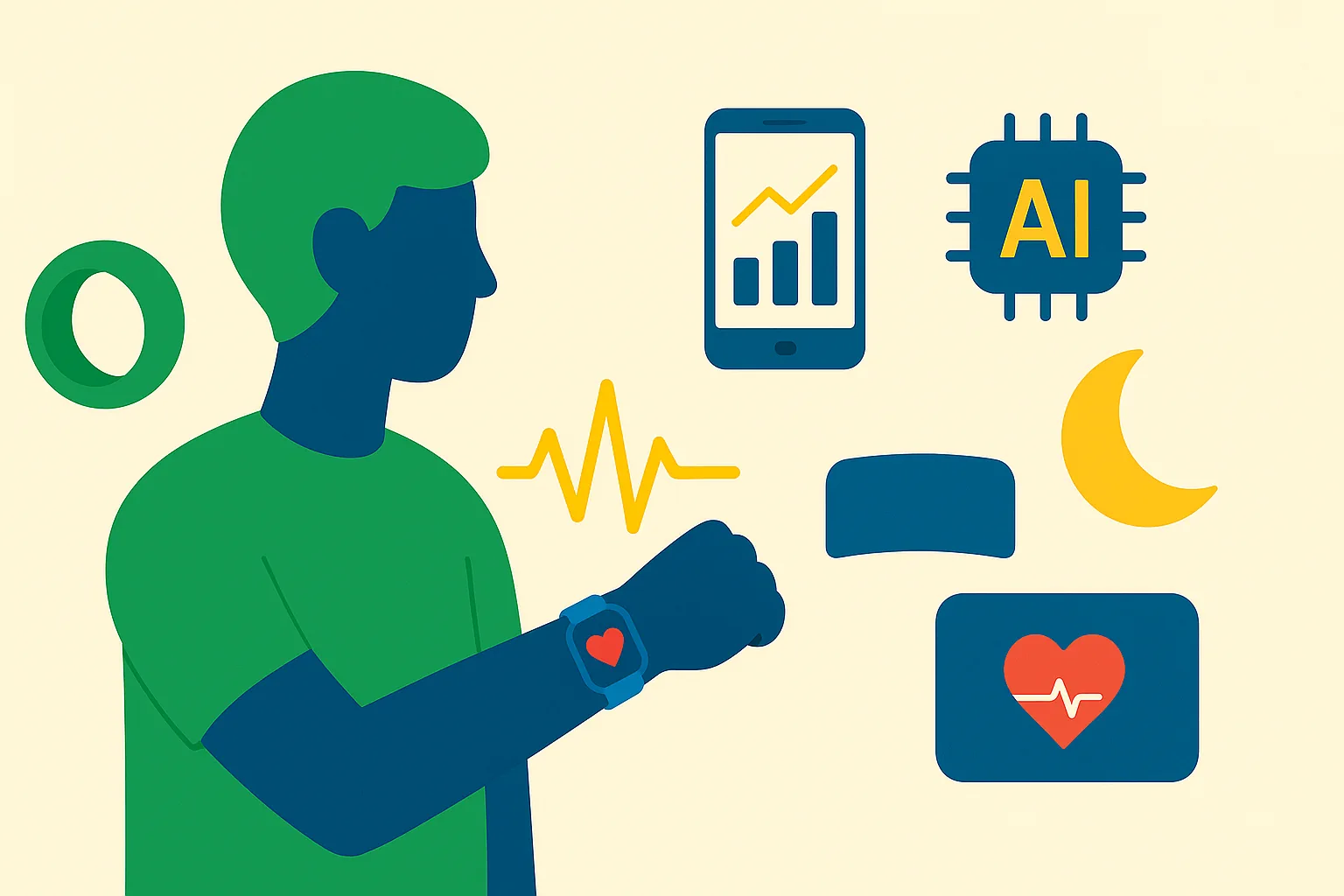Ten years ago, a fitness tracker on your wrist could do one thing: count steps. Fast forward to today, and that same wristband might warn you about stress before you feel it, flag an irregular heartbeat, or suggest a recovery plan after a tough night’s sleep.
This evolution isn’t just about gadgets getting smarter. It’s about the rise of AI-driven personalization — tools that no longer measure health in averages but tailor advice to the rhythms of your own body. From nutrition apps that adjust meal plans based on glucose spikes to rings that monitor your sleep cycles in minute detail, technology is no longer a bystander in wellness. It’s becoming an active partner.
The question is: are these tools making us healthier, or just more measured?
From Step Counters to Health Coaches
Wearables aren’t new. The first wave — pedometers and fitness trackers — simply measured steps. But today’s devices go far beyond counting. They monitor heart rate variability, oxygen saturation, skin temperature, menstrual cycles, and even stress levels through electrodermal activity.
On top of that, AI algorithms now interpret these streams of data in real time. Instead of saying “you slept 6 hours,” your app might recommend a higher protein breakfast or suggest skipping a workout if your recovery markers are low. In effect, wearables have evolved from passive trackers to active coaches.
Personalization: The Promise of AI
The biggest draw of AI-driven wellness is personalization. No more one-size-fits-all diet or exercise plan. Instead, tools like Whoop, Oura Ring, and AI-powered nutrition apps analyze your unique patterns.
- Sleep & Recovery: Devices track sleep stages and advise on bedtime routines or naps.
- Nutrition: Some apps use food logging, biomarker testing, or even continuous glucose monitoring to suggest personalized diets.
- Fitness: Algorithms adapt workout intensity based on fatigue and recovery data.
- Mental Health: AI chatbots and mindfulness apps provide tailored stress-reduction strategies.
The idea is compelling: technology that doesn’t just tell you what’s “healthy,” but what’s healthy for you.
The Science Behind the Screens
Personalized wellness tech isn’t just hype. Research is starting to catch up:
- A 2022 study in NPJ Digital Medicine found that AI-guided activity coaching led to a 14% increase in daily step counts compared to generic advice.
- Continuous glucose monitoring paired with AI recommendations has been shown to reduce post-meal glucose spikes, even in non-diabetics.
- Sleep-tracking wearables can accurately detect disturbances and help users improve bedtime routines, though they’re not as precise as lab polysomnography.
The takeaway: while not flawless, these tools can meaningfully support behavior change — especially when combined with human motivation.
The Risks and Limitations
But there’s another side to the story. With so much data, more isn’t always better.
- Accuracy Concerns: Not all wearables are equally reliable. Heart rate sensors, for example, may be less accurate for people with darker skin tones or during intense activity.
- Data Overload: Constant tracking can create anxiety or even obsession, a phenomenon psychologists call “orthosomnia” (poor sleep caused by worrying about sleep scores).
- Privacy Risks: Sensitive health data is stored in apps and clouds, raising concerns about who owns and profits from it.
- Equity Gaps: These devices aren’t cheap, and widespread adoption risks deepening health disparities.
As Dr. John Torous of Harvard Medical School notes: “The promise is exciting, but the pitfalls are real. We need to make sure these tools empower, not overwhelm.”
Behavioral Nudges: Helpful or Manipulative?
AI excels at nudges — small prompts that steer behavior. But where’s the line between support and manipulation?
When a wearable suggests a walk because you’ve been sedentary, that’s helpful. But what if the same data is used to market supplements, insurance products, or gym memberships? Critics warn that commercial interests may bias recommendations.
The challenge for the future: balancing personalization with transparency, so users understand why they’re being nudged — and who benefits.
Integration With Healthcare
Another trend is the merging of consumer wearables with clinical care. Doctors increasingly use patient-generated health data to guide treatment. For instance, cardiologists may review Apple Watch ECG data, or endocrinologists may integrate CGM reports into diabetes care.
The potential is enormous: continuous, real-world data could complement snapshot lab tests, giving a fuller picture of health. But it also raises questions about liability and workload for healthcare providers already stretched thin.
The Future: Wellness as a Feedback Loop
What’s clear is that wellness technology is shifting from reactive to proactive. Instead of waiting for illness, AI tools aim to catch subtle patterns early — nudging us toward preventive action.
Looking ahead, we may see:
- Integration with genomics: Apps tailoring diets or fitness based on genetic profiles.
- Emotional AI: Devices detecting mood shifts through voice, facial cues, or biomarkers.
- Closed-loop systems: Tech that not only monitors but actively adjusts — like wearables that regulate light exposure to improve circadian rhythms.
In this future, wellness becomes a feedback loop, where data, AI, and behavior constantly interact.
Why This Matters Now
The timing isn’t accidental. Post-pandemic, people are hyper-aware of their health. Remote monitoring boomed during lockdowns. At the same time, AI is advancing rapidly, making real-time insights feasible for consumers.
Culturally, we’re also shifting: from generic “fitness” to personalized self-optimization, from one-off fixes to continuous self-tracking. Whether empowering or exhausting, the movement is here to stay.
The Takeaway
AI tools and wearables are not magic bullets. They can’t replace intuition, balance, or professional care. But they do offer something new: a mirror that reflects our habits in real time, helping us align intentions with actions.
The key is to use them as guides, not dictators. The most valuable wellness insights are those that empower us to live with awareness, balance, and agency.
As the saying goes in tech: “What gets measured gets managed.” The challenge in wellness is making sure what we measure truly matters.
References
- Piwek, L., Ellis, D.A., Andrews, S., & Joinson, A. (2016). “The Rise of Consumer Health Wearables: Promises and Barriers.” PLoS Med. Link
- Althoff, T. et al. (2017). “Large-scale physical activity data reveal worldwide activity inequality.” Nature. Link

